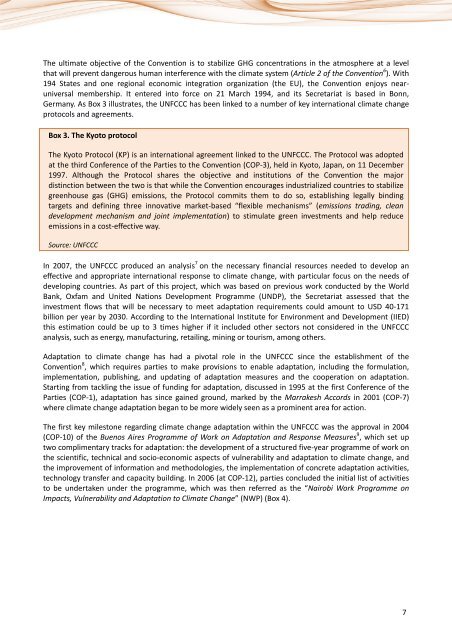Information and communication technologies (ICTs) and ... - ITU
Information and communication technologies (ICTs) and ... - ITU
Information and communication technologies (ICTs) and ... - ITU
Create successful ePaper yourself
Turn your PDF publications into a flip-book with our unique Google optimized e-Paper software.
The ultimate objective of the Convention is to stabilize GHG concentrations in the atmosphere at a level<br />
that will prevent dangerous human interference with the climate system (Article 2 of the Convention 6 ). With<br />
194 States <strong>and</strong> one regional economic integration organization (the EU), the Convention enjoys nearuniversal<br />
membership. It entered into force on 21 March 1994, <strong>and</strong> its Secretariat is based in Bonn,<br />
Germany. As Box 3 illustrates, the UNFCCC has been linked to a number of key international climate change<br />
protocols <strong>and</strong> agreements.<br />
Box 3. The Kyoto protocol<br />
The Kyoto Protocol (KP) is an international agreement linked to the UNFCCC. The Protocol was adopted<br />
at the third Conference of the Parties to the Convention (COP-3), held in Kyoto, Japan, on 11 December<br />
1997. Although the Protocol shares the objective <strong>and</strong> institutions of the Convention the major<br />
distinction between the two is that while the Convention encourages industrialized countries to stabilize<br />
greenhouse gas (GHG) emissions, the Protocol commits them to do so, establishing legally binding<br />
targets <strong>and</strong> defining three innovative market-based “flexible mechanisms” (emissions trading, clean<br />
development mechanism <strong>and</strong> joint implementation) to stimulate green investments <strong>and</strong> help reduce<br />
emissions in a cost-effective way.<br />
Source: UNFCCC<br />
In 2007, the UNFCCC produced an analysis 7 on the necessary financial resources needed to develop an<br />
effective <strong>and</strong> appropriate international response to climate change, with particular focus on the needs of<br />
developing countries. As part of this project, which was based on previous work conducted by the World<br />
Bank, Oxfam <strong>and</strong> United Nations Development Programme (UNDP), the Secretariat assessed that the<br />
investment flows that will be necessary to meet adaptation requirements could amount to USD 40-171<br />
billion per year by 2030. According to the International Institute for Environment <strong>and</strong> Development (IIED)<br />
this estimation could be up to 3 times higher if it included other sectors not considered in the UNFCCC<br />
analysis, such as energy, manufacturing, retailing, mining or tourism, among others.<br />
Adaptation to climate change has had a pivotal role in the UNFCCC since the establishment of the<br />
Convention 8 , which requires parties to make provisions to enable adaptation, including the formulation,<br />
implementation, publishing, <strong>and</strong> updating of adaptation measures <strong>and</strong> the cooperation on adaptation.<br />
Starting from tackling the issue of funding for adaptation, discussed in 1995 at the first Conference of the<br />
Parties (COP-1), adaptation has since gained ground, marked by the Marrakesh Accords in 2001 (COP-7)<br />
where climate change adaptation began to be more widely seen as a prominent area for action.<br />
The first key milestone regarding climate change adaptation within the UNFCCC was the approval in 2004<br />
(COP-10) of the Buenos Aires Programme of Work on Adaptation <strong>and</strong> Response Measures 9 , which set up<br />
two complimentary tracks for adaptation: the development of a structured five-year programme of work on<br />
the scientific, technical <strong>and</strong> socio-economic aspects of vulnerability <strong>and</strong> adaptation to climate change, <strong>and</strong><br />
the improvement of information <strong>and</strong> methodologies, the implementation of concrete adaptation activities,<br />
technology transfer <strong>and</strong> capacity building. In 2006 (at COP-12), parties concluded the initial list of activities<br />
to be undertaken under the programme, which was then referred as the “Nairobi Work Programme on<br />
Impacts, Vulnerability <strong>and</strong> Adaptation to Climate Change” (NWP) (Box 4).<br />
7

















